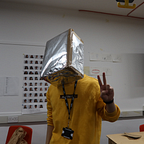11/02/21–25/03/21 (6 weeks)
📃Brief: Design a way to mitigate the effects of loneliness.
🤝Group Members: Alex Newson, Cat Achieng, Damul Yang, Huijie Xiong (Rikkie), Maria Carolina Séves, Tiana Robison Randriaharimalala, Sue An, Yiwei Han (David).
👁🗨External Partner: R/GA — Zoha Zoya, Matt Chokshi.
Narrow Down — Two directions
Looking back at the feedback from the previous week, I discovered a key point that we had overlooked when conducting our directly storytelling — the effect of loneliness. Perhaps we should have specified a situation before brainstorming. But we didn’t, which led to a completely different application scenario, audience, and mitigation for each creative idea.
The broad research gives us various ideas and inspiration but can lead to indecision as to which direction is best to take. Now we need to take the time to look at each of the ideas we came up with in our brainstorming session and choose the one that has the most potential and interest.
We split into two groups based on interest: Alex, Tiana, Cat continued to explore creative larp; Damul, Sue, Rikkie, Maria and I continued to discuss alternative possibilities.
First Direction: Exploration of Communication
Findings of my second round research:
1. Four main interventions to reduce loneliness (Masi et al., 2010):
I. Improving social skills.
II. Enhancing social support.
III. Increasing opportunities for social interaction. (Jellyfish & tail idea)
IV. Addressing abnormal social cognition (faulty patterns of thoughts, such as the hyper-vigilance often caused by chronic loneliness).
2. Nostalgia also has a restorative effect, counteracting loneliness by increasing perceived social support (Zhou et al., 2008).
Based on my Analysis of the diversity of loneliness situations and Sue’s similar “black hole concept” perspective: getting people who are not lonely to care for and help lonely people, we started to define specific groups of people. We discussed that loneliness is a common experience for everyone, and that everyone is constantly moving between being lonely and not being lonely. So it is not necessarily one person helping the other, but both helping each other when they need each other. We did some case studies and decided to explore communication between young people away from home and their families, increasing communication between the two to reduce their loneliness.
Focusing on the concept of ‘anthropomorphism’ from the literature review: The higher one’s sense of loneliness, the more one tends to anthropomorphize non-human entities and the importance of gestures and body language in communication, we came up with two ideas.
These two ideas mainly serve a specific situation: when inner thoughts between family members cannot be conveyed by words and spoken language, this subtle indirect communication tool may help to do so.
Prototype
We created a low-fidelity prototype and scenario of ‘Tails’ using simple physical materials. After the presentation, the tutor felt that we lacked a deep analysis of the effect of loneliness and pointed out that our ideas were too technology-centric and lacked consideration of physical materials and other methods. And that both ideas were also very difficult to implement in terms of technology. We decided to start thinking about new directions and consider their later feasibility and accessibility.
Reflection
As the age range of the people on this design brief also includes us, many of the need we put forward are actually based on our own experiences and assumptions, leading to the problem of ‘subjective design’. We need to re-focus on the real situation and real needs of the real audience.
📚Reference:
Cacioppo, J and Patrick, W. (2008) Loneliness: Human Nature and the Need for Social Connection. New York: W.W.Norton.
Masi, C.M., Chen, H.-Y., Hawkley, L.C. and Cacioppo, J.T. (2010). A Meta-Analysis of Interventions to Reduce Loneliness. Personality and Social Psychology Review, [online] 15(3), pp.219–266. Available at: https://www.ncbi.nlm.nih.gov/pmc/articles/PMC3865701/.
Zhou, X., Sedikides, C. and Wildschut, T. (2008). Counteracting loneliness 1 Running head: COUNTERACTING LONELINESS In press; Psychological Science Counteracting Loneliness: On the Restorative Function of Nostalgia. [online] . Available at: https://eprints.soton.ac.uk/63844/1/Zhou_et_al__2008.pdf [Accessed 7 Apr. 2021].
